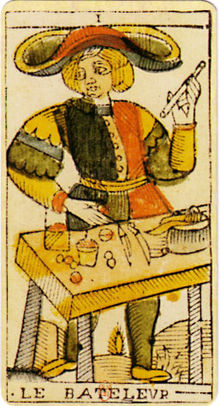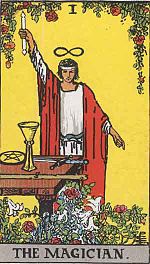The Magician - Tarot card
The Magician, The Magus, or The Juggler (I) is the first trump or Major Arcana card in most traditional Tarot decks. It is used in game playing as well as in divination. In divination it is considered by some to succeed The Fool card, often numbered 0 (zero).
Iconography

The Mountebank, from the Tarot of Marseille
In French Le Bateleur, "the mountebank" or the "sleight of hand artist", is a practitioner of stage magic. The Italian tradition calls him Il Bagatto or Il Bagatello. The Mantegna Tarocchi image that would seem to correspond with the Magician is labeled Artixano, the Artisan; he is the second lowest in the series, outranking only the Beggar. Visually the 18th-century woodcuts reflect earlier iconic representations, and can be compared to the free artistic renditions in the 15th-century hand-painted tarots made for the Visconti and Sforza families. In the painted cards attributed to Bonifacio Bembo, the Magician appears to be playing with cups and balls.
In esoteric decks, occultists, starting with Oswald Wirth, turned Le Bateleur from a mountebank into a magus. The curves of the magician's hat brim in the Marseilles image are similar to the esoteric deck's mathematical sign of infinity. Similarly, other symbols were added. The essentials are that the magician has set up a temporary table outdoors, to display items that represent the suits of the Minor Arcana: Cups, Coins, Swords (as knives). The fourth, the baton (Clubs) he holds in his hand. The baton later stands for a literal magician's "wand".
The illustration of the Tarot card "The Magician" from the Rider-Waite tarot deck was developed by A. E. Waite for the Hermetic Order of the Golden Dawn in 1910. Waite's magician features the infinity symbol over his head, and an ouroboros belt, both symbolizing eternity. The figure stands among a garden of flowers, to imply the manifestation and cultivation of desires. Waite was a key figure in the development of modern Tarot interpretation, though not all interpretations follow his theology.
In the tarot game
In most tarot games, the Bagatto is the lowest ranking trump card but worth a lot of points. Therefore many players want to take a trick when it is played. In most games played out of Italy, winning the last trick with it awards bonus points.
In tarocchini, the Bégato still serves as the lowest trump but it has an added ability. During score counting, it and the Fool can function as limited wild cards known as counters (contatori). They can be used separately or together to fill missing gaps in combinations but they can't fill in two consecutive gaps in sequential combinations. They can't replace the highest trump or kings. Both cards can be used in every sequence but as the Fool can't be captured while the Magician is vulnerable, the player holding the Magician would want to use it only judiciously.
In Sicilian tarocchi, the Bagatto is the second lowest trump, outranking an unnumbered trump called Miseria which isn't significant.
Symbolism
In the Magician's right hand is a wand raised toward heaven, the sky or the element æther, while his left hand is pointing to the earth. This iconographic gesture has multiple meanings, but is endemic to the Mysteries, symbolizing divine immanence, the ability of the magician to bridge the gap between heaven and earth. On the table in front of the Magician the symbols of the four Tarot suits signify the Classical elements of earth, air, fire and water. Beneath are roses and lilies, the flos campi and lilium convallium, changed into garden flowers, to show the culture of aspiration.
Divination
When the Magician appears in a spread, it points to the talents, capabilities and resources at the querent's disposal. Depending on the card's placement in relation to other cards, the message is to tap into one's full potential rather than holding back, especially when there is a need to transform something. There are choices and directions to take. Guidance can arrive through one's own intuition or in the form of someone who brings about change or transformation.
The card can mean that a manipulator is floating around, usually if it's reversed. He may be a beneficent guide, but he does not necessarily have our best interests in mind. He may also represent the querent’s ego or self-awareness. He can also represent the intoxication of power, both good and bad.
According to Arthur Edward Waite, this card signifies the divine motive in man. It is also the unity of the individual being on all planes, and in a very high sense it is thought. With further reference to the "sign of life", i.e. the infinity symbol and its connection with the number 8, it may be remembered that Christian Gnosticism speaks of rebirth in Christ as a change "unto the Ogdoad." The mystic number is termed Jerusalem above, the Land flowing with Milk and Honey, the Holy Spirit and the Land of the Lord. According to Martinism, 8 is the number of Christ.
In pop culture
- The Magician appears in the popular Roguelike game The Binding of Isaac as one of many usable tarot cards. The Magician makes Isaac's attacks gaining homing abilities for a single room.
- The Magician is a final boss in The House of the Dead series, depicted as a tall humanoid entity with the ability to control fire. The character has appeared in multiple installments due to his popularity.
- In JoJo's Bizarre Adventure, one of the main characters of the third arc series, Muhammed Avdol, has a Stand called Magician's Red, who can control fire. It was named after this tarot card.
- This card represents the character Meltina Melvis in the anime series Gen'ei o Kakeru Taiyō.
- In episode 184 of the long running and ongoing anime Detective Conan/Case Closed, the television prophet Nagara Haruka shows this tarot card when pointing out that the culprit of Suou Beniko's murder would've had to have blood on their person and needed time to wash it out.
In art
- The Surrealist (Le surréaliste), 1947, is a painting by Victor Brauner. The Juggler provided Brauner with a key prototype for his self-portrait: the Surrealist’s large hat, medieval costume, and the position of his arms all derive from this figure who, like Brauner’s subject, stands behind a table displaying a knife, a goblet, and coins.
COMMENTS








 The Magician (I), from the
The Magician (I), from the  The Mountebank, from the Tarot of Marseille
The Mountebank, from the Tarot of Marseille